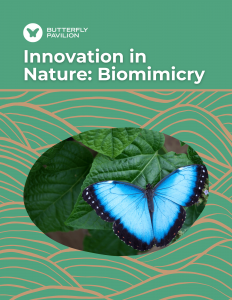Innovation in Nature: Biomimicry
6th-12th Grade
Cost: $5
Dive into the world of biomimicry with your students and learn about the cutting-edge solutions that can be found in nature! Your students will see innovation in action while learning how bees, ants, butterflies, and more have inspired human inventions. This lesson covers the basic tenets of biomimicry, how it is being used today, and how your students can find solutions to different problems just by observing nature.

Redistribution Policy:
Nothing in this lesson plan may be copied or reproduced without written permission from Butterfly Pavilion, except for student worksheets, which may be reproduced for educational use in connection with the activities provided.
Tax Exemption
If you are purchasing with a tax-exempt card, please reach out to education@butterflies.org so that we can exclude tax from your purchase.
Questions?
For questions about our downloadable lesson plans, email us at education@butterflies.org. Email is the best way to reach the Registrar.
If you prefer to speak by phone, call us at 720-974-1861.
Next Generation Science Standards Supported:
- MS-LS2-5 Evaluate competing design solutions for maintaining biodiversity and ecosystem services.
- MS-ESS3-2 Analyze and interpret data on natural hazards to forecast future catastrophic events and inform the development of technologies to mitigate their effects.
- MS-ESS3-3 Apply scientific principles to design a method for monitoring and minimizing human impact on the environment.
- MS-ETS1-1 Define the criteria and constraints of a design problem with sufficient precision to ensure a successful solution, taking into account relevant scientific principles and potential impacts on people and the natural environment that may limit possible solutions.
- MS-ETS1-2 Evaluate competing design solutions using a systematic process to determine how well they meet the criteria and the constraints of the problem.
- HS-LS2-7 Design, evaluate, and refine a solution for reducing the impacts of human activities on the environment and biodiversity.
- HS-ESS3-2 Evaluate competing design solutions for developing, managing, and utilizing energy and mineral resources based on cost-benefit ratios.
- HS-ESS3-4 Evaluate or refine a technological solution that reduces impacts of human activities on natural systems.
- HS-ETS1-1 Analyze a major global challenge to specify qualitative and quantitative criteria and constraints for solutions that account for societal needs and wants.
- HS-ETS1-2 Design a solution to a complex real-world problem by breaking it down into smaller, more manageable problems that can be solved through engineering.


